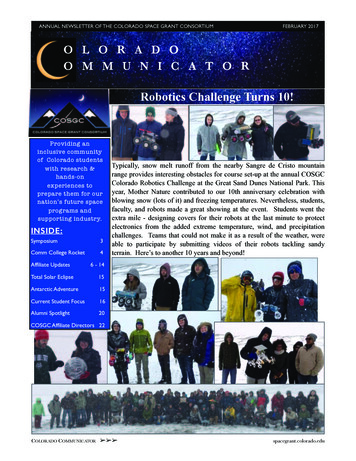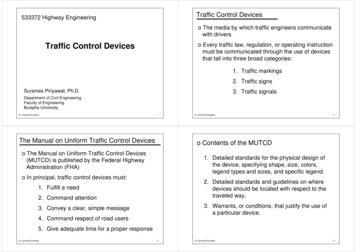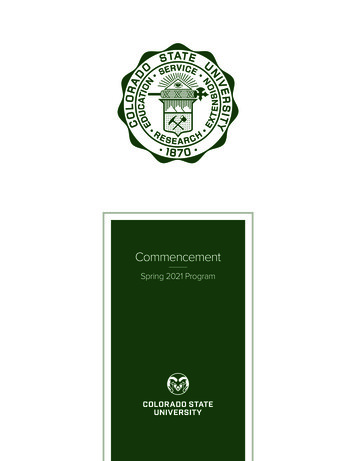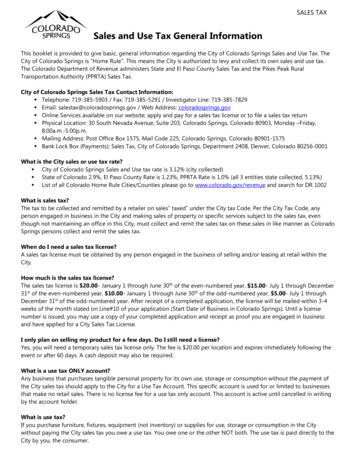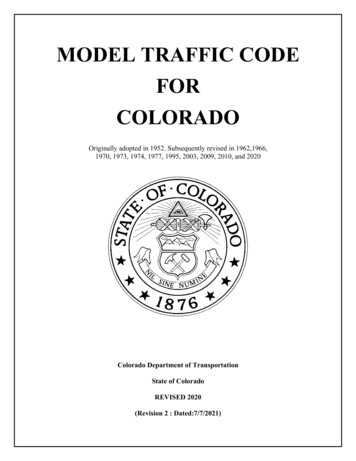
Transcription
MODEL TRAFFIC CODEFORCOLORADOOriginally adopted in 1952. Subsequently revised in 1962,1966,1970, 1973, 1974, 1977, 1995, 2003, 2009, 2010, and 2020Colorado Department of TransportationState of ColoradoREVISED 2020(Revision 2 : Dated:7/7/2021)
TABLE OF CONTENTSPART 1TRAFFIC REGULATION - GENERALLY101. Short title.102. Legislative declaration.103. Scope and effect of C – exceptions to provisions.104. Adoption of traffic control manual.105. Local traffic control devices.106. Who may restrict right to use highways.107. Obedience to police officers.108. Public officers to obey provisions - exceptions for emergency vehicles.109. Low-power scooters, animals, skis, skates, and toy vehicles on highways.109.5. Low-speed electric vehicles.109.6. Class B low-speed electric vehicles - effective date - rules.110. Provisions uniform throughout state.110.5. Automated vehicle identification systems.111. Powers of local authorities.112. Noninterference with the rights of owners of realty.113. Appropriations for administration of article.114. Removal of traffic hazards.115. Information on traffic law enforcement - collection - profiling - annual report - repeal.(Repealed)116. Restrictions for minor drivers - definitions.117. Personal mobility devices.PART 2EQUIPMENT201. Obstruction of view or driving mechanism - hazardous situation.202. Unsafe vehicles - penalty – identification plates.203. Unsafe vehicles - spot inspections.204. When lighted lamps are required.205. Head lamps on motor vehicles.206. Tail lamps and reflectors.207. Clearance and identification.208. Stop lamps and turn signals.209. Lamp or flag on projecting load.210. Lamps on parked vehicles.i
211. Lamps on farm equipment and other vehicles and equipment.212. Spot lamps and auxiliary lamps.213. Audible and visual signals on emergency vehicles.214. Visual signals on service vehicles.215. Signal lamps and devices – additional lighting equipment.215.5. Signal lamps and devices – street rod vehicles and custom motor vehicles.216. Multiple-beam road lights.217. Use of multiple-beam lights.218. Single-beam road-lighting equipment.219. Number of lamps permitted.220. Low-power scooters – lighting equipment - department control - use and operation.221. Bicycle and personal mobility device equipment.222. Volunteer firefighters – volunteer ambulance attendants – special lights and alarm systems.223. Brakes.224. Horns or warning devices.225. Mufflers - prevention of noise.226. Mirrors - exterior placements.227. Windows unobstructed – certain materials prohibited – windshield wiper requirements.228. Restrictions on tire equipment.229. Safety glazing material in motor vehicles.230. Emergency lighting equipment - who must carry.231. Parking lights.232. Minimum safety standards for motorcycles and low-power scooters.233. Alteration of suspension system.234. Slow-moving vehicles - display of emblem.235. Minimum standards for commercial vehicles236. Child restraint systems required - definitions - exemptions.237. Safety belt systems – mandatory use - exemptions - penalty.238. Blue and red lights - illegal use or possession.239. Misuse of a wireless telephone - definitions - penalty - preemption.240. Low-speed electric vehicle equipment requirements.PART 3EMISSIONS INSPECTION(Omitted)PART 4DIESEL INSPECTION PROGRAM(Omitted)ii
PART 5SIZE - WEIGHT - LOAD501. Size and weight violations - penalty.502. Width of vehicles.503. Projecting loads on passenger vehicles.504. Height and length of vehicles.505. Longer vehicle combinations.506. Trailers and towed vehicles.507. Wheel and axle loads.508. Gross weight of vehicles and loads.509. Vehicles weighed – excess removed.510. Permits for excess size and weight and for manufactured homes - rules.511. Permit standards - state and local.511.2. Authority for cooperative agreements with regional states on excess size or weightvehicles - regulations.512. Liability for damage to highway.PART 6SIGNALS - SIGNS - MARKINGS601. Department to sign highways, where.602. Local traffic control devices.603. Obedience to official traffic control devices.604. Traffic control signal legend.605. Flashing signals.606. Display of unauthorized signs or devices.607. Interference with official devices.608. Signals by hand or signal device.609. Method of giving hand and arm signals.610. Unauthorized insignia.611. Paraplegic persons or persons with disabilities - distress flag.612. When signals are inoperative or malfunctioning.613. Failure to pay toll established by regional transportation authority.614. Designation of highway maintenance, repair, or construction zones- signs - increase in penalties for speeding violations.615. School zones - increase in penalties for moving traffic violations.iii
PART 7RIGHTS-OF-WAY701. Vehicles approaching or entering intersection.702. Vehicle turning left.703. Entering through highway – stop or yield intersection.704. Vehicle entering roadway.705. Operation of vehicle approached by emergency vehicle– operation of vehicle approaching stationary emergency vehicle.706. Obedience to railroad signal.707. Certain vehicles must stop at railroad grade crossings.708. Moving heavy equipment at railroad grade crossing.709. Stop when traffic obstructed.710. Emerging from or entering alley, driveway, or building.711. Driving on mountain highways.712. Driving in highway work area.713. Yielding right-of-way to transit buses - definitions - penalty.PART 8PEDESTRIANS801. Pedestrian obedience to traffic control devices and traffic regulations.802. Pedestrians’ right-of-way in crosswalks.803. Crossing at other than crosswalks.804. Pedestrian to use right half of crosswalk. (Repealed)805. Pedestrians walking or traveling in a wheelchair on highways.806. Driving through safety zone prohibited.807. Drivers to exercise due care.808. Drivers and pedestrians, other than persons in wheelchairs, to yield to persons withdisabilities.PART 9TURNING - STOPPING901. Required position and method of turning.902. Limitations on turning around.903. Turning movements and required signals.iv
PART 10DRIVING - OVERTAKING - PASSING1001. Drive on right side - exceptions.1002. Passing oncoming vehicles.1003. Overtaking a vehicle on the left.1004. When overtaking on the right is permitted.1005. Limitations on overtaking on the left.1006. One-way roadways and rotary traffic islands.1007. Driving on roadways laned for traffic.1008. Following too closely.1008.5. Crowding or threatening bicyclist.1009. Coasting prohibited.1010. Driving on divided or controlled access highways.1011. Use of runaway vehicle ramps.1012. High occupancy vehicle (HOV) and high occupancy toll (HOT) lanes.1013. Passing lane - definitions - penalty.PART 11SPEED REGULATIONS1101. Speed limits.1102. Altering of speed limits.1103. Minimum speed regulation.1104. Speed limits on elevated structures.1105. Speed contests - speed exhibitions - aiding and facilitating– immobilization of motor vehicle - definitions.PART 12PARKING1201. Starting parked vehicle.1202. Parking or abandonment of vehicles.1203. Ski areas to install signs.1204. Stopping, standing, or parking prohibited in specified places.1205. Parking at curb or edge of roadway.1206. Unattended motor vehicle.1207. Opening and closing vehicle doors.1208. Parking privileges for persons with disabilities - applicability.1209. Owner liability for parking violations.v
1210. Designated areas on private property for authorized vehicles.1211. Limitations on backing.1212. Pay parking access for disabled.PART 13ALCOHOL AND DRUG OFFENSESPART 14OTHER OFFENSES1401. Reckless driving - penalty.1402. Careless driving - penalty.1403. Following fire apparatus prohibited.1404. Crossing fire hose.1405. Riding in trailers.1406. Foreign matter on highway prohibited.1407. Spilling loads on highways prohibited- prevention of spilling of aggregate, trash, or recyclables.1407.5. Splash guards - when required.1408. Operation of motor vehicles on property under control of orowned by parks and recreation districts.1409. Compulsory insurance - penalty - legislative intent.1410. Proof of financial responsibility required - suspension of license.1411. Use of earphones while driving.1412. Operation of bicycles and other human-powered vehicles.1413. Eluding or attempting to elude a police officer.1414. Use of dyed fuel on highways prohibited.1415. Radar jamming devices prohibited - penalty.PART 15MOTORCYCLES1501. Traffic laws apply to persons operating motorcycles – special permits.1502. Riding on motorcycles – protective helmet.1503. Operating motorcycles on roadways laned for traffic.1504. Clinging to other vehicles.vi
PART 16ACCIDENTS AND ACCIDENT REPORTS(Omitted)PART 17PENALTIES AND PROCEDURE1701. Traffic offenses and infractions classified- penalties – penalty and surcharge schedule - repeal.1702. Alcohol- or drug-related traffic offenses - collateral attack.1703. Parties to a crime.1704. Offenses by persons controlling vehicles.1705. Person arrested to be taken before the proper court.1706. Juveniles - convicted – arrested and incarcerated - provisions for confinement.1707. Summons and complaint or penalty assessment notice for misdemeanors,petty offenses, and misdemeanor traffic offenses - release - registration.1708. Traffic infractions - proper court for hearing, burden of proof - appeal - collateral attack.1709. Penalty assessment notice for traffic infractions- violations of provisions by officer - driver’s license.1710. Failure to pay penalty for traffic infractions- failure of parent or guardian to sign penalty assessment notice - procedures.1711. Compliance with promise to appear.1712. Procedure prescribed not exclusive.1713. Conviction record inadmissible in civil action.1714. Traffic violation not to affect credibility of witness.1715. Convictions, judgments, and charges recorded – public inspection.1716. Notice to appear or pay fine – failure to appear - penalty.1717. Conviction - attendance at driver improvement school - rules.1718. Electronic transmission of data - standards.1719. Violations - commercial driver’s license - compliance with federal regulation.PART 18VEHICLES ABANDONED ON PUBLIC PROPERTY1801. Legislative declaration.1802. Definitions.1803. Abandonment of motor vehicles - public property.1804. Report of abandoned motor vehicles - owner’s opportunity to request hearing.1805. Appraisal of abandoned motor vehicles - sale.vii
1806. Liens upon towed motor vehicles.1807. Perfection of lien.1808. Foreclosure of lien.1809. Proceeds of sale.1810. Transfer and purge of certificates of title.1811. Penalty.1812. Exemptions.1813. Local regulations.1814. Violation of motor vehicle registration or inspection laws – separate statutory provision.PART 19SCHOOL BUS REQUIREMENTS1901. School buses - equipped with supplementary brake retarders.1902. School bus drivers - special training required.1903. School buses - stops - signs - passing.1904. Regulations for school buses – regulations on discharge of passengers - penalty exception.viii
APPENDICES1) Definitions2) PART A.Instructions for adopting the model traffic code by reference3) PART B.Specimen ordinance for adopting model traffic code by reference4) PART C.Specimen notice of hearing5) PART D.Specimen certification – posting of notice6) PART E.Instructions for amending Model Code previously adopted by reference7) PART F.Listing of amendments for updating previous editions of the Model TrafficCode adopted by reference8) PART G.Specimen certification of Model Code9) Why a Model Traffic Code?ix
FORWARDBecause of the significant mobility of today’s traffic and the influx of motorists from manyareas, every driver has a right to expect the rules governing the movement of vehicles andpedestrians on streets and highways are clearly defined and reasonably uniform throughout thestate and the nation.The General Assembly of the State of Colorado has recognized that conflicts between the state’straffic laws and municipal traffic ordinances lead to inconsistencies in the movement of trafficand has strengthened the requirements for uniformity of traffic regulations in the followingterms:“This article constitutes the uniform traffic code throughout the state and in all politicalsubdivisions and municipalities therein”. (Source: 42- 4-110 (1), C.R.S.)“All local authorities may, in the manner prescribed in article 16 of title 31, C.R.S., or in article15 of title 30, C.R.S., adopt by reference all or any part of a model traffic code which embodiesthe rules of the road and vehicle requirements set forth in this article and such other additionalregulations as are provided for in section 42-4-111; except that, in the case of state highways,any such additional regulations shall have the approval of the department of transportation”.(Source: 42-4-110 (1)(b), C.R.S.)“No local authority shall adopt, enact, or enforce on any street which is a state highway anyordinance, rule, or resolution which alters or changes the meaning of the “rules of the road” or isotherwise in conflict with the provisions of this article. For the purpose of this section, the “rulesof the road” shall be construed to mean any of the regulations on the operation of vehicles setforth in this article which drivers throughout the state are required to obey without the benefit ornecessity of official traffic control devices as declared in section 42-4-603 (2).” (Source: 42- 4110(1)(c), C.R.S.)These provisions leave little doubt that the basic driving rules are expected to be uniformstatewide for the protection of Colorado drivers and pedestrians. If state laws and localgovernment traffic codes are to serve their purpose they must complement one another and begiven the widest possible publicity as companion documents.The National Committee on Uniform Traffic Laws and Ordinances points out that it is not theproper purpose of traffic legislation to impose unnecessary or unreasonable restrictions on streetor highway traffic, but to ensure, as far as this can be done by law and its enforcement, thattraffic shall move smoothly, efficiently and safely; that no legitimate user of the street orhighway, whether in a vehicle or on foot, shall be killed, injured or frustrated in such use by theimproper behavior of others.x
Through the cooperative efforts of both state and local governments, the “Model Traffic Codefor Colorado” has been developed to make available a specimen set of motor vehicle and trafficregulations that track state law.Section 42-4-105, C.R.S., states that all traffic control devices placed or maintained by localauthorities shall conform to the most recent edition of the federal “Manual on Uniform TrafficControl Devices” (MUTCD) and the state supplement thereto.Traffic regulatory areas preempted by state law have not been made part of the Code. Localgovernments are urged to bring their traffic ordinances into harmony with the current Code.Local governments that adopt the Code by reference are cautioned not to make any changes oradditions which are in conflict with state law. However, the adopting local governments are atliberty to delete any parts, articles, or sections which are deemed to be inapplicable. A specimenordinance and specimen public notices for adopting the Code by reference will be found in theAppendix.The following official state documents work in tandem to provide a uniform system of trafficregulation and accepted traffic engineering practices for greater operational efficiency and safety: Colorado Revised Statutes (C.R.S.), Title 42, Article 4 - Uniform traffic code for the State ofColorado. Updated periodically to correlate with national model legislation.Model Traffic Code for Colorado – Model ordinance embodies provisions of Colorado Lawapplicable to driving in municipalities and counties in a form that can be adopted byreference.Colorado Drivers Manual – Drivers’ handbooks authorized by Colorado statute. Issued by theColorado Department of Revenue (Division of Motor Vehicles). Traffic control text andillustrations developed by the Colorado Department of Transportation.Manual on Uniform Traffic Control Devices (MUTCD) – Manual of Federal HighwayAdministration approved traffic control devices. Updated periodically and adopted by theTransportation Commission as required by Colorado Law.xi
PART 1TRAFFIC REGULATION - GENERALLY101. Short title.102. Legislative declaration.103. Scope and effect of Code – exceptions to provisions.(1) This Code constitutes the model traffic code throughout this jurisdiction.(2) The provisions of this Code relating to the operation of vehicles and the movement ofpedestrians refer exclusively to the use of streets and highways except:(a) Where a different place is specifically referred to in a given section;(b) For provisions of sections 1401, 1402 and 1413 of this Code which shall apply uponstreets and highways and elsewhere throughout the jurisdiction.104. Adoption of traffic control manual.- See Appendices Part A.105. Local traffic control devices.Local authorities shall place and maintain such traffic control devices upon highwaysunder their jurisdiction as they may deem necessary to indicate and to carry out the provisions ofthis Code or local traffic ordinances or to regulate, warn, or guide traffic, subject in the case ofstate highways to the provisions of sections 42-4-110 and 43-2-135 (1) (g), C.R.S. All suchtraffic control devices shall conform to the state manual and specifications for statewideuniformity as provided in section 42-4-104, C.R.S.106. Who may restrict right to use highways.(1) Local authorities with respect to highways under their jurisdiction may by ordinanceor resolution prohibit the operation of vehicles upon any such highway or impose restrictions asto the weight of vehicles to be operated upon any such highway, for a total period of not toexceed ninety days in any one calendar year, whenever any said highway by reason ofdeterioration, rain, snow, or other climatic conditions will be seriously damaged or destroyedunless the use of vehicles thereon is prohibited or the permissible weights thereof reduced.(2) After enacting any such ordinance signs designating the permissible weights shall beerected and maintained.(3) This local government, with respect to highways under its jurisdiction, may also, byordinance or resolution, prohibit the operation of trucks or other commercial vehicles ondesignated highways or may impose limitations as to the weight thereof, which prohibitions andlimitations shall be designated by appropriate signs placed on such highways.1
(4) The department of transportation shall likewise have authority as granted in thissection to local authorities to determine by resolution and to impose restrictions as to the weightof vehicles operated upon any highway under the jurisdiction of said department, and suchrestrictions shall be effective when signs giving notice thereof are erected upon the highways orportion of any highway affected by such resolution.(4.5) (a) The department of transportation has authority to close any portion of a statehighway to public travel.(b) (I) A person who operates a motor vehicle or vehicle combination over thirty-fivefeet in length on state highway 82 between mile markers 47 and 72 in violation of a closureunder paragraph (a) of this subsection (4.5) is subject to an enhanced penalty as set forth insection 1701 (4) (a) (I) (F).(II) A person who operates a motor vehicle or vehicle combination over thirty-five feetin length on state highway 82 between mile markers 47 and 72 in violation of a closureunder paragraph (a) of this subsection (4.5) where the result of the violation is an incidentthat causes the closure of a travel lane in one or both directions, is subject to an enhancedpenalty as set forth in section 1701 (4)(a)(I)(F).(5) (a) (I)(A) The department of transportation may close any portion of a state highway for publicuse during dangerous driving conditions, during construction or maintenance operations, or whennecessary for the protection and safety of the public.(B) When icy or snow-packed conditions exist on the highway, the department oftransportation may restrict travel on or use of any portion of a state highway by any motorvehicle unless the motor vehicle is equipped with the following: Tire chains or an alternatetraction device; four-wheel drive with tires that have a tread depth of at least three sixteenths ofan inch and that are adequate for the conditions; all-wheel drive with tires that have a tread depthof at least three sixteenths of an inch and that are adequate for the conditions; or tires that areimprinted by a manufacturer with a mountain-snowflake, “MS”, “M S”, or “M/S” symbol orthat are all-weather rated by the manufacturer and that have a tread depth of at least threesixteenths of an inch.(C) A closure or restriction under this subsection (5) is effective when signs, includingtemporary or electronic signs, that notify the public of the closure or restriction are erected uponthe highway, and the restriction in subsection (5)(a)(I)(B) of this section is effective on interstate70 between milepost 133 (Dotsero) and milepost 259 (Morrison) from September 1 through May31 of each year. It is unlawful to proceed when a state highway is closed or to proceed when arestriction is in effect without the equipment required by this subsection (5).(D) The Colorado state patrol shall cooperate with the department of transportation in theenforcement of a closing or restriction under this subsection (5).(E) The driver of a commercial vehicle with four or more drive wheels, other than a bus,shall affix tire chains to at least four of the drive wheel tires when the vehicle is required to beequipped with tire chains under this subsection (5). The driver of a bus shall affix tire chains to at2
least two of the drive wheel tires when the vehicle is required to be equipped with tire chainsunder this subsection (5).(F) A person who violates this subsection (5)(a)(I) commits a traffic infraction and issubject to the penalties in section 42-4-1701 (4)(a)(I)(F).(II) Any person who operates a motor vehicle in violation of restrictions imposed by thedepartment of transportation or the state patrol under subparagraph (I) of this paragraph (a),where the result of the violation is an incident that causes the closure of a travel lane in one orboth directions, shall be subject to an enhanced penalty as set forth in section 42-4-1701(4)(a)(I)(F).(III) A person who violates subparagraph (I) of this paragraph (a) while operating acommercial vehicle shall be subject to an enhanced penalty as set forth in section 42-4-1701(4)(a)(I)(F).(IV) A person who violates subparagraph (I) of this paragraph (a) while operating acommercial vehicle and the violation causes a closure in a travel lane shall be subject to anenhanced penalty as set forth in section 42-4-1701 (4)(a)(I)(F).(V) If a fine is enhanced under subparagraphs (III) and (IV) of this paragraph (a), theportion of the fine that exceeds the fine imposed under subparagraph (I) for an enhancementunder subparagraph (III), or subparagraph (II) for an enhancement under subparagraph (IV), thatis allocated to the state by sections 42-1-217 and 43-4-205, C.R.S., shall be transferred to thestate treasurer, who shall deposit it in the highway construction workers’ safety account withinthe highway users tax fund created by section 42-4-1701 (4)(c)(II)(B), to be continuouslyappropriated to the department of transportation for work zone safety equipment, signs, and lawenforcement.(VI) Subparagraphs (III) and (IV) of this paragraph (a) shall not apply to a tow operatorwho is towing a motor vehicle or traveling to a site from which a motor vehicle shall be towed.(VII) The Colorado department of transportation shall identify an appropriate place forcommercial vehicles to apply chains, if necessary, to comply with subparagraph (I) of thisparagraph (a) and provide adequate notice to commercial vehicle operators of such places.(b) The transportation commission may promulgate rules to implement the provisions ofthis subsection (5).(c) As used in this subsection (5):(I) “Alternate traction device” means a device that is approved by the Coloradodepartment of transportation as capable of providing traction comparable to that of metal chainsor tire cables under similar conditions.(II) “Equipped” means that a motor vehicle uses or carries the appropriate tractionequipment for icy or snow-packed conditions.(III) “Tire chains” means metal chains consisting of two circular metal loops, one oneach side of the tire, connected by no fewer than nine evenly spaced chains across the tire tread.3
(6)(a) Local authorities may, within their respective jurisdictions, for the purpose of roadconstruction and maintenance, temporarily close to through traffic or to all vehicular traffic anyhighway or portion thereof for a period not to exceed a specified number of workdays for projectcompletion and shall, in conjunction with any such road closure, establish appropriate detours orprovide for an alternative routing of the traffic affected when, in the opinion of concerned localauthorities, as evidenced by resolution or ordinance, such temporary closing of the highway orportion thereof and the rerouting of traffic is necessary for traffic safety and for the protection ofwork crews and road equipment. Such temporary closing of the highway or portion thereof andthe routing of traffic along other roads shall not become effective until official traffic controldevices are erected giving notice of the restrictions, and, when such devices are in place, nodriver shall disobey the instructions or directions thereof.(b) Local authorities, within their respective jurisdictions, may provide for the temporaryclosing to vehicular traffic of any portion of a highway during a specified period of the day forthe purpose of celebrations, parades, and special local events or civil functions when in theopinion of said authorities such temporary closing is necessary for the safety and protection ofpersons who are to use that portion of the highway during the temporary closing.(c) Local authorities shall enter in to agreements with one another for the establishment,signing and marking of appropriate detours and alternative routes which jointly affect local roadsystems and which are necessary to carry out the provisions of paragraphs (a) and (b) of thissubsection (6). Any temporary closing of the street which is a state highway and any reroutingof state highway traffic shall have the approval of the department before such closing becomeseffective.(7) A person who violates any provision of this section commits a class B trafficinfraction.107. Obedience to police officers.No person shall willfully fail or refuse to comply with any lawful order or direction ofany police officer invested by law with authority to direct, control, or regulate traffic. Anyperson who violates any provision of this section commits a class 2 misdemeanor traffic offense.108. Public officers to obey provisions - exceptions for emergency vehicles.(1) The provisions of this Code applicable to the drivers of vehicles upon the highwaysshall apply to the drivers of all vehicles owned or operated by the United States, this state, or anycounty, city, town, district, or other political subdivision of the state, subject to such specificexceptions as are set forth in this Code with reference to authorized emergency vehicles.(2) The driver of an authorized emergency vehicle, when responding to an emergencycall, or when in pursuit of an actual or suspected violator of the law, or when responding to butnot upon returning from a fire alarm, may exercise the privileges set forth in this section, butsubject to the conditions stated in this Code. The driver of an authorized emergency vehicle may:(a) Park or stand, irrespective of the provisions of this Code or State law;4
(b) Proceed past a red or stop signal or stop sign, but only after slowing down as may benecessary for safe operation;(c) Exceed the lawful speeds set forth in section 1101(2) or exceed the maximum lawfulspeed limits set forth in section 1101 (8) so long as said driver does not endanger life or property;(d) Disregard regulations governing directions of movement or turning in specifieddirections.(3) The exemptions and conditions provided in paragraphs (b) to (d), in their entirety, ofsubsection (2) of this section for an authorized emergency vehicle shall apply only when suchvehicle is making use of audible or visual signals meeting the requirements of section 213, andthe exemption granted in paragraph (a) of subsection (2) of this section shall apply only whensuch vehicle is making use of visual signals meeting the requirements of section 213 unless usingsuch visual signals would cause an obstruction to the normal flow of traffic; except that anauthorized emergency vehicle being operated as a police vehicle while in actual pursuit of asuspected violator of any provision of this title need not display or make use of audible or visualsignals so long as such pursuit is being made to obtain verification of or evidence of the guilt ofthe suspected violator. Nothing in this section shall be construed to require an emergency vehicleto make use of audible signals when such vehicle is not moving, whether or not the vehicle isoccupied.(4) The provisions of this section shall not relieve the driver of an authorized emergencyvehicle from the duty to drive with due regard for the safety of all persons, nor shall suchprovisions protect the driver from the consequences of such driver’s reckless disregard for thesafety of others.109. Low-power scooters, animals, skis, skates, and toy vehicles on highways.(1) A person riding a low-power scooter upon a roadway where low-power scooter travelis permitted shall be granted all of the rights and shall be subject to all of the duties and penaltiesapplicable to the driv
MODEL TRAFFIC CODE FOR COLORADO Originally adopted in 1952. Subsequently revised in 1962,1966, 1970, 1973, 1974, 1977, 1995, 2003, 2009, 2010, and 2020 Colorado Department of Transportation State of Colorado REVISED 2020 (Revision 2 : Dated:7/7/2021) i TABLE OF CONTENTS PART 1 TRAFFIC REGULATION - GENERALLY







